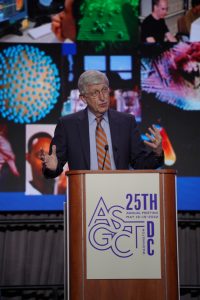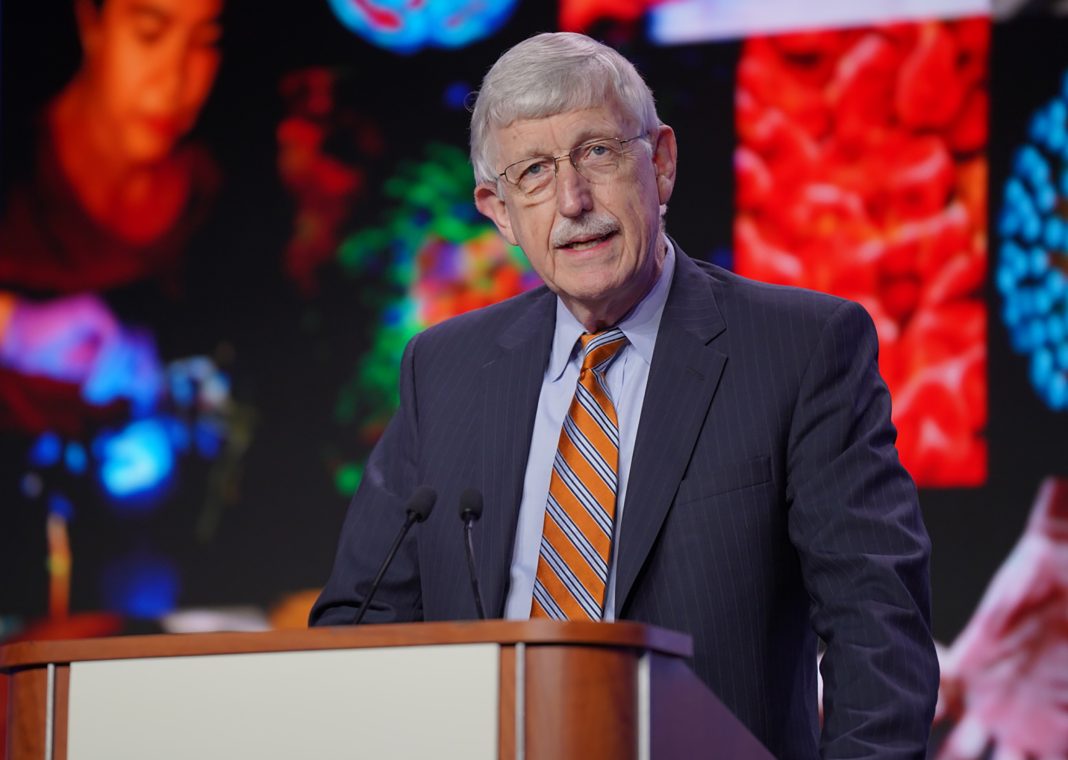WASHINGTON, DC — In his current role as President Biden’s acting scientific advisor, Francis Collins, MD, PhD, is dealing with a wide range of issues from semiconductor shortages to wildfires. “But my heart is in what you are all doing here at this meeting,” he told a packed house at the American Society of Gene and Cell Therapy (ASGCT) annual conference, which is being held in Washington, DC, this week.
Collins made a quick trip across town from the White House to accept the ASGCT’s inaugural Founder’s Award. He was praised by society president Beverly Davidson, PhD, not only for his service as NIH director (stepping down at the end of 2021) but also for his stewardship of the Human Genome Project (HGP), without which many gene therapy programs would be years behind their current schedule. He is currently the acting White House chief science advisor following the resignation earlier this year of Eric Lander, PhD.

“We’ve celebrated the human genome a few times. This time it’s for real, people!”
The success of the HGP has enabled close to 7,000 human genetic disorders to be identified. But most of those rare diseases still lack treatment and are still waiting for their turn,” Collins said. And while human gene therapy had made great strides over the past two decades, many disorders “won’t be managed by an ex vivo therapy approach.”
And that was the central theme of Collins’ lecture—both to highlight recent successes and to seek greater progress in making in vivo genome editing scalable to treat many more patients. Many current gene therapies are produced as one-offs, Collins said. “We need a transformative approach” so it’s less painful to take a good idea to the clinic and on to approval by the FDA.
A new public-private partnership is poised to test a templated approach with a vector that’s been evaluated, then swapping in the key insert to get a much faster track to FDA approval. The Bespoke Gene Therapy Consortium (BGTC) is an NIH-Industry-FDA partnership for ultra-rare diseases, which is managed through the Foundation for the NIH (FNIH). Collins paid tribute to Peter Marks, MD, PhD, director of the Center for Biologics Evaluation and Research, FDA, and Michael Dolsten, MD, PhD, CSO, Pfizer, who have championed the BGTC program. Initially, the consortium will focus on adeno-associated virus (AAV), “the vector that’s furthest along.” The consortium seeks to improve understanding of AAV biology and develop a short list of candidate diseases.
Ten NIH institutes are joining the FDA and multiple industry partners, including Biogen, Pfizer, Ultragenyx, Takeda, Taysha, and Danaher. Half-a-dozen pilot projects will be selected from more than 60 submitted proposals, with the goal of taking a bespoke approach to rare diseases. “Let’s see if we can make this work,” Collins said.
Progress in progeria
Over the past two decades, one of Collins’ personal research priorities has been to continue work on a rare genetic form of premature aging called Hutchinson-Gilford progeria syndrome (HGPS), which affects about 200 patients worldwide.
“We’ve been obsessed with this disorder,” Collins said, since the mutated gene was discovered in the early 2000s. (A splice site mutation in the lamin A gene produces a toxic truncated protein called progerin.) The FDA has approved a drug therapy, but it’s not a cure, Collins said. An RNA therapy developed in collaboration with Sarepta, SRP-2001, shows a survival benefit in a mouse model, and is moving to a clinical trial.
But it is Collins’ work on a DNA therapy, in partnership with David Liu, PhD (Broad Institute) that has caught particular attention. Using a base editing approach developed in Liu’s laboratory, the idea is “let’s just fix the mutation!” Early work using lentiviral transduction of progeria patient fibroblasts significantly reduced the proportion of cells with the C base mutation, and almost fully suppressed production of the abnormal progerin protein.
In an HGPS mouse model that the Collins lab helped develop, the investigators switched to an AAV vector. “I thought the chances this would achieve reasonable levels in a mouse model with a single infusion were not that great,” Collins confessed. But the experiment resulted in 70% correction levels in the liver, and respectable levels of 25% in the heart, quadriceps, and aorta. Moreover, the survival curve in the treated mice is even better than following RNA treatment, Collins said, as he showed a video clip illustrating a stark contrast between treated and control mice.
“We’re really excited,” Collins said, and are “in the midst of steps to bring this forward for a very bold idea, IV infusion of AAV9… for kids with this disease, to find the mutation and fix it in all the right places.”
In vivo indeed
“Why in vivo? Why gene editing?” Collins asked rhetorically as he returned to his central theme. “There are thousands of rare diseases. I want to find something that’s scalable.”
As a natural example, Collins chose sickle-cell disease, which he worked on as a postdoc in the 1980s at Yale University. “At last, ‘the first molecular disease’ has a molecular therapy,” Collins said. Indeed, it has several: Lentiglobin, from the work of Collins’ NIH colleague John Tisdale, MD, and Bluebird bio, has shown a “remarkable benefit of clinical response,” with no patients experiencing any vaso-occlusive events following treatment. Other ex vivo approaches, including an oligonucleotide strategy led by David Williams, MD, (Boston Children’s Hospital) and CRISPR (Vertex Pharmaceuticals and CRISPR Therapeutics) are also working well.
But these successes highlight the need to produce in vivo delivery methods wherever possible. “In most diseases, it’s not feasible to take out tissue,” Collins said. You can’t do ex vivo therapy on the brain, for example. Moreover, current ex vivo approaches are complex, risky, and expensive.
Genome editing is not limited to just gene replacement or recessive diseases. (HGPS is a case in point, as it is caused by gain-of-function mutations.) Another goal is to deliver the therapeutic via a single infusion, which should limit the need for long-term therapy and reduce overall costs.
“Delivery is the real challenge! We need a zip code system for human tissues,” Collins said, a method to deliver the gene-editing apparatus to the right cells safely and effectively.
The NIH Common Fund project has launched the Somatic Cell Genome Editing program, which brings together experts in gene editing with targeted delivery. (The program has issued four new FOAs for Phase II—applications are due in July 2022.)
A “great example” of in vivo genome editing is work reported by Intellia Therapeutics in 2021, for a rare liver disorder, using lipid nanoparticles. Collins highlighted recent work published by André Lieber, MD, PhD, Chang Li, PhD, and colleagues using in vivo targeting of hematopoietic stem cells using an adenovirus carrying the fetal globin gene and a CRISPR construct to knock out the upstream binding site of the well-known BCL11A repressor.
The work essentially “cures SCD in a mouse model,” Collins said. And he could not resist noting that he led the discovery of that upstream globin variant as a postdoc way back in 1985, in work published in Nature. Along with unpublished data from Intellia, Collins said this approach is “not so pie in the sky as I’d have thought a couple of years ago.”
Clearly, ex vivo therapy for 100,000 SCD patients is out of the question, even before acknowledging that most of the patients are spread across Africa and India. “We have to come up with a strategy” to help these patients, Collins said.
In a collaboration with the Bill and Melinda Gates Foundation, NIH is mounting an effort for a one-shot SCD cure that could be administered in a low-resource setting. Ambitiously, Collins said his team thought, “let’s cure HIV at the same time.”
Collins concluded by thanking his audience while urging them to do more. “Of nearly 7,000 genetic disorders, only 500–600 have an FDA-approved therapy,” he said. The goal is to develop therapies for the thousands of disorders for which patients and their families are still waiting in vain.
He was rewarded with a standing ovation.


